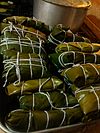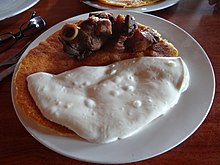| Name |
Image |
Description
|
| Arepa |
 |
Ground maize dough cooked, typically grilled on a budare (which is similar to a comal) or deep-fried in a regular pan. The arepa is served filled, similar to a sandwich. There are many fillings including shredded beef, black beans, Venezuelan cheese, ham, fish. Some fillings have proper names. Reina Pepiada (old Venezuelan Spanish for "curvy queen") is a filling for arepa composed of avocado, chicken, and mayonnaise. This particular filling is named after the Venezuelan beauty queen Susana Duijm.[3]
|
| Arepa andina |
 |
Same as arepas but made with wheat. Popular in the Venezuelan Andes region.
|
| Cachapa |
 |
A maize pancake, usually filled with fresh cheese and/or fried pork
|
| Cachitos (de jamón) |
 |
Similar to French croissant filled with ham
|
| Caraotas negras |
 |
Black beans, usually eaten at lunch time, with rice, plantains and shredded meat, or pabellón
|
| Casabe |
 |
A flat bread made of bitter cassava
|
| Chicharrón |
 |
Typically fried pork rinds and eaten as a snack, or as a side dish
|
| Chupe andino |
|
A soup traditionally made with cheese, shredded chicken or hen, vegetables and cream.
|
| Ensalada de pollo |
 |
Chicken salad, usually made with mayonnaise, green cabbage and carrots
|
| Hallaca |
 |
A typical Christmas dish; hallacas typically have a mixture of beef, pork, chicken, capers, raisins, and olives wrapped in maize (cornmeal dough), bound with string within plantain leaves, and boiled or steamed afterwards
|
| Humitas |
 |
Small tamales consumed throughout the Andes region of South America, including the Venezuelan Andes region
|
| Huevos pericos |
 |
Scrambled eggs, butter, sautéed diced onions, and tomatoes; used often to fill an arepa
|
| Hervido de gallina |
 |
Hen soup, usually with chunks of corn, potatoes, carrots and local root vegetables such as cassava, ñam, auyama (name for local variety of pumpkin), ocumo (cocoyam), and seasoned with onions, garlic, and cilantro[4]
|
| Mandoca |
 |
Deep-fried cornmeal ring
|
| Mondongo |
 |
Soup made from diced tripe and slow cooked vegetables
|
| Pabellón criollo |
 |
Creole pavilion, the national dish: white rice, shredded beef in stew, tajadas (fried ripe plantains) and stewed black beans
|
| Pastel de pollo |
 |
Chicken pot pie
|
| Polvorosa de pollo
|
|
Caracas version of chicken pot pie made with pâte sablée
|
| Pastelitos |
 |
Fried puff pastries, famously a specialty of the Venezuelan Andes. These are made with wheat flour dough, and filled with, for example, cheese and chicken. Usually pastelitos are eaten at breakfast[5]
|
| Pasticho |
 |
Similar to the Greek dish pastitsio and the Italian lasagna[6]
|
| Polenta |
 |
Also known as "funche" in some areas of the country
|

























